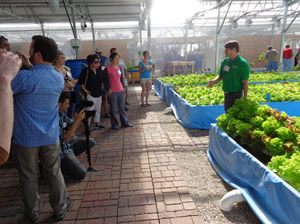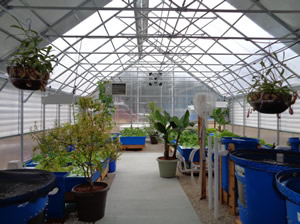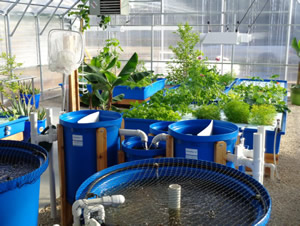Teaching Tools for K-12; Aquaponics, Aeroponics, and Closed Loop Food Systems
Article Overview
The purpose of the article is to identify the need for K-12 School Teaching Tools that use closed loop food production systems for the future; both for space travel and to feed the fast growing population on our planet. Closed loop food systems are needed to conserve planet resources, use water efficiently, and grow more food using fewer energy and natural resources. This article is meant be a resource for administrators, teachers, and students about closed loop food systems and sources for future learning.
Since the early humans in space; with NASA’s Project Mercury’s with Alan Shepard, the first USA orbital flight of Friendship 7’s with John Glenn, and Sally Ride, the first American woman in space in 1983; we have needed to provide food in space. As we approach the Asteroid Missions of the 2020’s, the Mar’s Missions of the 2030’s, and the future colonization of distant planets we will have a greater need to feed humans using closed loop food technology. With the advent of the internet, students are now capable of viewing the International Space Station research. NASA and the European Space Agency both use closed loop food system techniques. Students are now studying closed loop food systems in our schools.
The planet’s population is anticipated to increase to between 9 and 10 billion by 2050. This means that the planet will need to develop food systems that are much more efficient and that will produce more food with less water. Aeroponic systems, co-developed with the help of NASA, can produce significantly more food per acre than traditional methods while saving the per acre water used to grow the food. Food systems called Aquaponics, the combination of raising fish and vegetables, also can significantly increase the amount and quality of food.
Rebecca Nelson and John Pade, founders of Nelson and Pade, Inc., specialize in aquaponics and controlled environment agriculture. They have provided teaching tools for schools, focusing on aquaponics and hydroponics, since the late 1980’s. Rebecca and John are both Adjunct Instructors at the University of Wisconsin - Stevens Point and co-developed and co-teach the first-of-its-kind University level Aquaponics Course, which has now evolved into the first Aquaponics Certificate program offered by an accredited University. Rebecca is the author of the book, Aquaponic Food Production as well as Aquaponics and Hydroponics Curriculums. She was the Editor and publisher of the Aquaponics Journal from 1997 – 2012. Bruce Haxton is a sustainable architect involved in science park design, laboratory design, and future “life style science parks” and technology cluster HUB’s. Mr. Haxton is the Team Leader for The NZ4 Global Alliance, a team of affiliated entities researching/designing sustainable facilities and closed loop planning prototypes. Nelson and Haxton have teamed up to provide the latest information related to current and future aquaponic, aeroponic, and closed loop food system and planning prototypes.
The article concept is to develop teaching tools and curriculum for the future researchers and food production people to satisfy the needs for increasing both quality and quantity for earth food production needs as well as for space exploration/colonization. The added benefit is to reduce or hopefully eliminate the need for petroleum based fertilizers, pesticides, and herbicides involved in food production; thereby creating a food system of the future that actually is sustainable, regenerative, and organically grown. The methods of closed loop food production showcased in this article can achieve this.
The article will show 12 typical K-12 school aquaponics systems and compare the system costs and area attributes. Within the article as many contacts as possible will be noted at the facilities. The information included will note as many sources as possible and related contacts.
Aquaponics, Aeroponics, and Vertical Farming Definitions:
Aquaponics: Aquaponics is the combination of aquaculture (fish farming) and hydroponics (soilless plant culture). It is an integrated system in which fish and vegetables are grown. It is a sustainable and efficient closed loop food production system.
Aeroponics: Systems that grow plants with high pressure misting nutrient water system, using no soil. This type of system can safe as much as 50-90% of the water resources.
Hydroponics: Growing plants in a nutrient water solution, without soil.
Leaf Sensor Technology: Technology attached to a plant that monitors plant conditions and sends electronic information back to growers of plant conditions.
VEGGIE: NASA Kennedy Space Center concept for food growth research currently used on the International Space Station.
MELiSSA: European Space Agency (ESA) system for studying closed loop food growth for space exploration.
Vertical Farming: Growing food in a vertical manner often in a closed loop manner; both fish and shrimp can be grown vertically.
Algae, Duckweed and Lemna minor: The culture of flowering aquatic plants which float on or just beneath the surface of still or slow-moving bodies of fresh water and wetlands. A high-protein food source for aquaculture, waterfowl, and humans; sometimes cited as a significant fast growing potential food source for Aquaculture.
Global Food Growth Systems Trends:
- Growing trend in personal closed loop environment food growth systems in a closed loop environments.
- Concern for planetary “holding capacity” for food, water, and resources is a recurring topic with the population increasing to 9-10 billion by 2050.
- Aquaponic, hydroponic, and aeroponic systems are now being used in schools as teaching tools.
- Internet access to the World Wide Web, NASA KSC, NASA JSC, and the International Space Station (ISS) related to their closed food research.
- With the pending NASA Asteroid missions (2020’s) and the MARS MISSION (2030’s) and potential Space Colony Mission (2030’s and beyond); there is a growing interest in closed loop food growth.
- European Space Agency “MELiSSA” closed loop food research for space exploration.
- NASA Kennedy Space Center (KSC) food research program “VEGGIE” both at KSC and ISS.
- Development of BEYOND as a NASA grant for increasing food production and reducing plant disease.
- Numerous space exploration and food system research at leading colleges and universities in support of NASA and ESA; University of Wisconsin, University of Colorado.
- Growing need to feed “failing states” and “underdeveloped country” populations.
- Diminishing water resources for food production globally.
- Increased need for closed loop solution for dealing with the growing global pollution.
- Increased concern about pesticide, herbicide, insecticide, etc. build up in our soils.
- Aquaponic food production is being used around the world in home systems, commercial ventures, and social efforts to provide fresh fish and vegetable to families, communities, and villages.
Aquaponics as a Teaching Tool:
Aquaponics is an integrated system that combines recirculating aquaculture and hydroponic (soilless) plant culture. In aquaponics, the nutrient-rich water that results from raising fish in an intensive system provides a natural fertilizer for the plants. Beneficial bacteria break the waste down into the elements the plants need. The plants remove the nutrients as they draw the elements through their roots as they grow. Aquaponics is an intensive co-culture system, with both fish and plants raised together, with benefits for both resulting from the integration.
In an aquaponic system, the inputs consist of food for the fish, energy to run water pumps and air blowers, fresh water to replace what the plants use, and labor. For best results, a quality, species-specific fish diet should be used to maintain a healthy fish population as well as a balanced stream of nutrients flowing to the plant roots. The fish eat the food and excrete waste. Ammonia is the primary waste component and at low levels, is toxic to fish. Nitrifying bacteria oxidize the ammonia, converting it to nitrite. Nitrite is also toxic to fish at low levels. Other nitrifying bacteria convert the nitrite to nitrate, which is the primary form of nitrogen for plants in an aquaponic system.
Unlike a natural waterway with a great deal of water and relatively few fish, the fish are densely stocked in an aquaponic system, resulting is rising ammonia and nitrite levels. As long as there is adequate habitat, aerobic conditions, and the proper environment for the nitrifying bacteria in an aquaponic system, the process of nitrification maintains levels of ammonia and nitrite for good fish health. It also generates the nitrogen that the plants need.
Another process, mineralization, happens in anaerobic conditions. In the mineralization process, heterotrophic bacteria break the fish waste solids and uneaten food into the other elements that plants need.
All of these inter-related processes are demonstrated in aquaponics, making it an ideal teaching tool that inspires students, energizes teachers, and generates enthusiasm from parents and stakeholders in the education system. Because of the unique educational model, an aquaponics project often will bring a school together, rallying around the concept of an integrated system that uses less water and resources and provides fresh food anywhere in the world.

Nelson and Pade
The Aquaponics Master ClassTM at Nelson and Pade Inc. To date, people from 78 countries and all 50 US states have attended this comprehensive course on aquaponic food production. Attendees include educators, entrepreneurs, families, and people who are interested in learning more about this sustainable, efficient method of growing fresh fish and vegetables in an integrated system.
Rebecca Nelson, co-founder of Nelson and Pade, Inc., has worked with schools throughout North America to help establish fully functional, science-based aquaponic systems and related curriculums. Nelson and Pade, Inc. offers extensive training programs, aquaponic project planning services, complete Clear Flow Aquaponic Systems®, and long term grower support. At their 14,000 sq. ft. demonstration facility in Montello, WI, they showcase commercial aquaponic systems as well as systems for home food production and school projects. This facility is open for tours. School groups, garden clubs and individuals often travel to Nelson and Pade, Inc. for a tour to learn, first hand, how aquaponics works.
The Aquaponics Master Class™ offered by Nelson and Pade, Inc. is a comprehensive 3-day course for anyone seriously interested in aquaponics. Educators, entrepreneurs, and individuals have travelled from 78 countries and all 50 US states to attend the Aquaponics Master Class™.
In partnership with the University of Wisconsin-Stevens Point (UWSP), Nelson and Pade, Inc. offers Master Class attendees University credit and Continuing Education Units. Additionally, UWSP offers a full semester Aquaponics Course, with all lectures and testing completed online. Offered through UWSP Continuing Education, the Aquaponics Course is available to individuals anywhere.

Nelson and Pade
This 24’ x 40’ greenhouse is an ideal size for a school aquaponics project. This one houses an F5 (Fantastically Fun Fresh Food Factory) and a Family Plus Clear Flow Aquaponic System®. An abundance of fish and vegetables are grown while demonstrating myriad facets of science, biology, horticulture, chemistry, engineering, mathematics, agriculture, and business.
Nelson and Pade, Inc.’s Clear Flow Aquaponic Systems® include everything needed to get started in aquaponics, including all tanks, stands, plumbing, the aeration system, detailed assembly, and operation manuals. The design of Clear Flow Aquaponic Systems® is based on proven methods, ratios, volumes, and techniques. For schools, Nelson and Pade, Inc. includes the Aquaponics Curriculum package which provides lessons, quizzes and guidance for the educator on how to integrate an aquaponic system in core curriculum subjects as well as suggestions on innovative interdisciplinary teaching.
As students are introduced to aquaponics, often they are inspired to better understand the science behind the technology. Aquaponics has spurred interest among students in biology and agriculture and has been the impetus for some students to plan a career in aquaponic farming. Aquaponics fills the need for sustainable, efficient farming that can be done anywhere in the world. The students working with aquaponics in the classroom have the potential to become the food producers of the future. An aquaponic program can, essentially, train students and provide job skills to work in a new and necessary field of food production.
Developing Countries and At Risk Communities, and Planetary Benefits

Nelson and Pade
The “Family Plus” Clear Flow Aquaponic System® is a science-based aquaponic system that annually produces nearly 5,000 heads of lettuce (or other vegetables) and 500 lbs. of fresh fish in 1,000 sq. ft. area. This is an excellent system for a school aquaponics program.
Clear Flow Aquaponic Systems® have also been customized for Missions in developing countries, Urban Centers, and Developing Country Community Assistance Centers. The Living Food Bank® system was developed to reduce the reliance on imported food for feeding programs in developing countries. For the Living Food Bank® the project is customized for the local climate, culturally focused food types, solar panels, battery bank, and generator backup. The Living Food Bank® can also be combined with the NZ4 Global Alliance “Community Assistance Centers” to supply healthcare, community meetings, and community learning facilities to help in the development of food, healthcare, learning, and job creation in underdeveloped areas.
Nelson and Pade Commercial Aquaponics Systems
Clear Flow Aquaponic Systems® can be developed into a “Life Style City / Campus” which is a live, work, play, educate, and train environment. The systems are Profitable, dependable, efficient, and sustainable. They also provide a “low environmental footprint” for the future; by efficiently using resources, reducing ‘food miles’, hands on training for future employment, and long term employment as food systems of the future develop into commercial enterprises.

Nelson and Pade
Commercial Clear Flow Aquaponic Systems® at Nelson and Pade, Inc.’s demonstration facility in Montello, WI
Commercial System Positive Attributes
- Complete Packages- with Proven Designs
- Systems that Maximize Production
- Continuous Food Harvests; 365 days per year
- Energy Efficiency
- On the job hand on training on proven advanced food systems
- In-depth knowledge of system pricing and life cycle costing
- Specifications for food systems
- ZDEP© “Near Zero Discharge-Extra Production” system
- Food production without using pesticides, herbicides, or chemical fertilizers.
- Nursery Systems for starting both plants and fish stock
- Purge System design including concepts for isolation , observation, holding, and hospital tanks concepts
- Nelson and Pade Grower Program
- Installation and Training Options
- Example 1: BTI Aquaponics, Baker Technical Institute
- Example 2: AguaLab, Canton Elementary STEM Academy
- Example 3: Washburn High School Aquaponic Program
- Example 4: Safe Harbor Academy
- Aquaponics Lessons Learned
- Benefits of Aquaponic Food Production
- Steps for Implementation of K-12 Aquaponics Closed Loop Teaching Tool
- NZ4 Global Alliance Life Style Science Parks / Technology Cluster HUB’s
- Kennedy Space Center and NASA’s Veggie System
- European Space Agency (ESA) MELiSSA Closed Loop Food System
- Richard Stoner’s AgriHouse, Inc. Aeroponics Food Growth System
- Dr. Addison Lawrence / truShrimp™ Vertical Aquaculture - Shrimp Growth System
- Tamra Fakhoorian / GreenSun Products, LLC Duckweed Information
Website Resources for Further Research
Books for Further Study
YouTube© Sites for further Study
Disclaimer:
The article is meant to open communication for further study into closed loop food systems and their application. Each facility and teaching tool needs to be analyzed and considered on its own merits. Each facility has specific attributes, codes, and parameters that need to be considered in total; seek professional help in any attempt at developing a closed loop food system or food system teaching tool.
Copyright © September 2015 Bruce Haxton and Rebecca Nelson. All rights reserved, other publication without written authorization is prohibited.
This article originally appeared in the issue of .